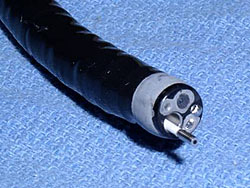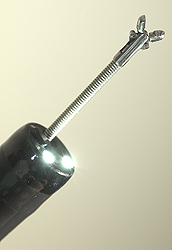Endoscopy
Endoscopy means "looking inside" and refers to looking inside the body for medical purposes. The instrument used for this procedure is called an endoscope.
Endoscopy is a minimally invasive diagnostic medical procedure commonly used to evaluate the interior surfaces of an organ by inserting a small tube into the body. Through the endoscope, the observer is able to see lesions of organs and other internal medical conditions.
In veterinary medicine, endoscopy is commonly used as a diagnostic procedure, for tissue and organ biopsies, to remove foreign objects (particularly in the stomach) or get an inside view of a particular part of your pet's body. Even though anesthesia is required to keep your pet still during the endoscopic procedure, the amount of anesthesia and recovery time is greatly reduced. Endoscopy is often indicated when routine blood and urine tests, radiographs and ultrasound do not give the complete diagnostic picture.
The endoscope is composed of a long tube (flexible or rigid), a light source, camera and viewing eyepiece. In addition to the fiber optic light source, there are two channels within in the tube. One channel is for passing forceps, snares or biopsy instruments, allowing for the removal of foreign objects, collection of biopsy samples and removal of small polyps or tumors. Air or water can be passed through the other channel for better viewing of the tissue or organ.

One can distinguish:
- the endoscope itself consisting of either a rigid or flexible tube.
- a light delivery system to illuminate the organ or object under inspection. The light source is normally outside the body and the light is typically directed via a fiber optic system.
- a lens system transmitting the image to the viewer from the fiberscope.
- an additional channel to allow entry of medical instruments to biopsy or to facilitate tissue and other operations.

Illustrations show magnification of endoscope's tip with biopsy equipment.

The benefits of endoscopy include shortened anesthetic time, decreased inflammation, less physiologic stress and discomfort and an earlier return to normal function. The endoscope is used to help diagnose and treat a variety of gastrointestinal and respiratory disorders. Depending on the symptoms, it is used to look at the inner lining of the throat, stomach, intestine, colon or at the respiratory passages (nose, throat and lungs). Even though general anesthesia is required for an endoscopic procedure, it is still considered much less invasive than traditional surgery due to the relatively short procedure length and low occurrence of complications.